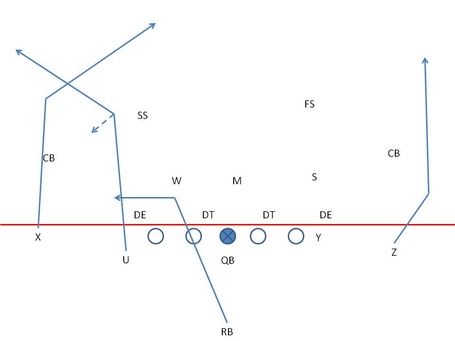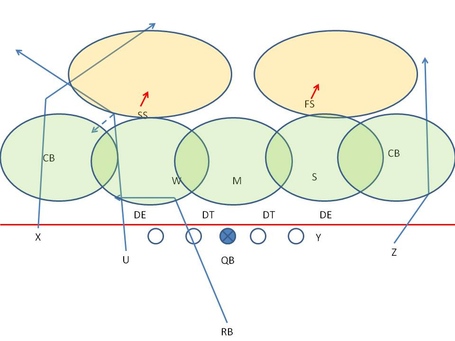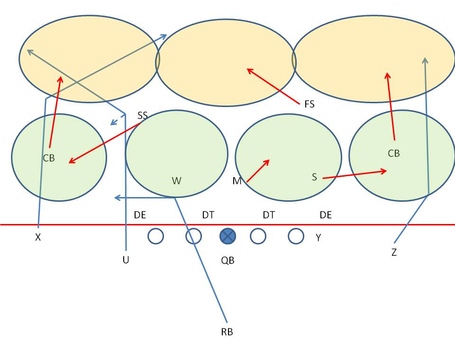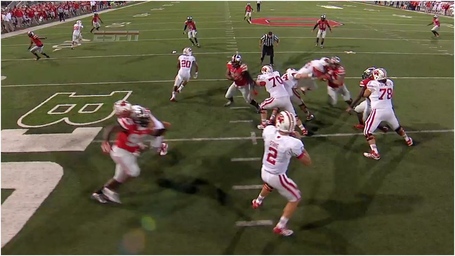Film Review: Adjusting Routes to Coverage
Originally posted at Bucky's 5th Quarter on Oct 3, 2013
Because Wisconsin has such run game prowess, many of its passing concepts attack the sidelines, away from the box area. In this area, the Badgers will often run "route adjustments" depending on the coverage. These adjustments allow the Wisconsin offense to attack multiple coverages with limited receivers, as other eligible receivers tend to be used to sell the run fake or help out in pass protection. They rely on the quarterback and receiver seeing the same thing, and if they don't, it often leads to bad things. In this post, I'm going to try to piece together where these issues were made and talk about why you have these adjustments within your offense.
This is a defense that is in Cover 2 (you see because Ohio State cornerback Bradley Roby is rolled up underneath before attempting to gain depth since no one threatens the flat; this may also be Cover 6, which was OSU's base defense in 2013, but Cover 6 plays as Cover 2 to the throw side of the field).
This needs to be a corner route, not a comeback route.
The easiest way to show why you use route adjustments is with diagrams. You see that the receiver has the option to run a comeback route or a corner route. This is a standard scissors concept with scissors adjustments.
This sight adjustment is used depending on the safeties. A single high safety (Cover 1, Cover 3) will sit, though against man the route likely will become more of an out route instead of a comeback so that the tight end can gain separation on his defender.
Against two high safeties (Cover 2, Cover 4) the No. 2 receiver (second from the outside) will attack the corner. In Cover 4, because the No. 1 receiver (farthest outside) hitches, the cornerback will come up and the defense will essentially play like Cover 2.
Likewise, you can run the same scissors concept but change the route by the RB from attacking the flat to a sit route. The sit route attacks that hook zone rather than the flat, and you can then have the U-Receiver adjust his route to an out route rather than a comeback route. If it is the LB that is typically responsible for the flat defense (typically in Cover 3, the LB will be responsible for the short side flat and the safety for the field flat) he will be influenced to stay inside on the RB and the Out may be a better threat. These small adjustments to the play call (changing the RB route) can change the route adjustments to the base concept, and can be adjusted to better attack defensive tendencies with offensive strengths. So for instance, if a team tends to run Cover 1, and your U-Receiver is a good athlete, adjusting the scissors concept to an out may be more to your advantage than having him run a comeback route, so you slightly adjust the play call by changing the RB route out of the backfield.
This one is a bit harder to tell. For one, what the receiver runs is a seam route all the way, down to where he takes his eyes after he passes the initial defender and how he doesn't turn his head until he is past the deep defender. It's also difficult to say because Wisconsin quarterback Joel Stave is hit as he throws. But...
If this wasn't meant to be an adjustment, there is no reason for Stave to pick this side to throw to. If this is simply a seam, which isn't a very good Cover 3-beater when there is nothing behind it to pick on the deep third, then he should have chosen the other side of the field, where he has an in/out underneath Cover 3-beater installed. But Stave looks like he gets a good read on the play and still chooses to go left, which to me means this play should theoretically be "mirrored" (both sides of the offense run the same route concept).
Second, look at Stave's footwork. Even if he isn't hit, his footwork is taking the ball directly where it is thrown. Now, getting hit probably causes the ball to float a bit, making it a bit high, but the ball takes a path that is directly in the bubble of the defense.
So, in my mind, it is likely that Stave intended to throw the ball in that general area (a bit lower, but he was hit), but the receiver failed to correctly read the coverage. Perhaps Stave just read the wrong side of the field, or maybe the play design is poor because carrying the seam just gets the receiver bracketed.
I don't believe either, though. This is the opposite issue as the last play diagrammed. Whether the receiver is aware of the route adjustment (he runs a seam the way you would run a seam against Cover 3 if there was a route behind it) or if he just fails to read the defense correctly is difficult to say, but that looks to be the problem here as well. Once he passes the first level defender, he needs to see Roby immediately sinking into a deep third and then sit in the bubble, creating an in/out on the flat defender. At that point, this becomes a fairly simple pitch and catch.
These are things that take reps and practice, both from the quarterback's perspective and from the receiver's, but to efficiently run an offense, particularly one that is so predicated on routes to the outside, these things need to be cleaned up if you want to move the ball consistently both on the ground and through the air. Many teams mitigate this issue by running 2x2 packaged concepts and having the QB read which side to attack based on his reading of the safeties. But this requires a bit more of a vertical attacking offense and limits your abilities to protect the passer or sell the run fake. A second option, triangle concepts attack any defense on the same side of the field, but still require route adjustments and more advanced reads from the QB, so aren't always easy to implement in total. So if you want to be a run based, play action focused attacking offense, route adjustments should be a core tenet of your scheme.
FWIW, and we can get to it at a later date, but many teams also adjust routes immediately at the snap based on the coverage type and leverage. We can get more detailed into the exact keys receivers are reading to make their route adjustments at that time.
Because Wisconsin has such run game prowess, many of its passing concepts attack the sidelines, away from the box area. In this area, the Badgers will often run "route adjustments" depending on the coverage. These adjustments allow the Wisconsin offense to attack multiple coverages with limited receivers, as other eligible receivers tend to be used to sell the run fake or help out in pass protection. They rely on the quarterback and receiver seeing the same thing, and if they don't, it often leads to bad things. In this post, I'm going to try to piece together where these issues were made and talk about why you have these adjustments within your offense.
Not adjusting to Cover 2
I'm starting on this play, where there is clear miscommunication, because it provides me evidence on the next play. After the play, the tight ends points to himself, saying, "my bad," because he sat down in the hook zone rather than taking the route to the corner.This needs to be a corner route, not a comeback route.
The easiest way to show why you use route adjustments is with diagrams. You see that the receiver has the option to run a comeback route or a corner route. This is a standard scissors concept with scissors adjustments.
Against a Cover 2, the open area is the corner route. You are picking on the safety to have to cover the post and the corner, and are holding the CB in the flat with the RB route. The corner location is one of the primary weaknesses of Cover 2.
In contrast, that hook/curl zone is pretty well covered by the outside linebacker. Throwing the ball there against Cover 2 is very dangerous because you have the safety over the top squeezing down and the outside linebacker gaining depth, meaning the ball needs to be put in a perfect window just to have a shot at a completion. So instead, you run the corner route to open grass. This puts the receiver in a position to gain distance from the safety and pick on the underneath corner.
But against Cover 3, that corner route has a defender sitting right in that location, with outside leverage, ready to defend the corner. So instead of picking on a weakness of Cover 2 when you see Cover 3, you adjust the route for the coverage. In this case, the U-receiver will run a comeback route, and along with the RB, will have and in/out read on the underneath defender. The U-Receiver runs his route behind the initial level, while the Post route attacks the seam and holds the two deep thirds defender from coming down to defend the U-Receiver. By working behind the underneath coverage, the RB can generally manipulate the coverage enough to allow the U-Receiver to find an opening and attack the flat defender in/out.
This sight adjustment is used depending on the safeties. A single high safety (Cover 1, Cover 3) will sit, though against man the route likely will become more of an out route instead of a comeback so that the tight end can gain separation on his defender.
Against two high safeties (Cover 2, Cover 4) the No. 2 receiver (second from the outside) will attack the corner. In Cover 4, because the No. 1 receiver (farthest outside) hitches, the cornerback will come up and the defense will essentially play like Cover 2.
Likewise, you can run the same scissors concept but change the route by the RB from attacking the flat to a sit route. The sit route attacks that hook zone rather than the flat, and you can then have the U-Receiver adjust his route to an out route rather than a comeback route. If it is the LB that is typically responsible for the flat defense (typically in Cover 3, the LB will be responsible for the short side flat and the safety for the field flat) he will be influenced to stay inside on the RB and the Out may be a better threat. These small adjustments to the play call (changing the RB route) can change the route adjustments to the base concept, and can be adjusted to better attack defensive tendencies with offensive strengths. So for instance, if a team tends to run Cover 1, and your U-Receiver is a good athlete, adjusting the scissors concept to an out may be more to your advantage than having him run a comeback route, so you slightly adjust the play call by changing the RB route out of the backfield.
Not adjusting to Cover 3
Here's the video:If this wasn't meant to be an adjustment, there is no reason for Stave to pick this side to throw to. If this is simply a seam, which isn't a very good Cover 3-beater when there is nothing behind it to pick on the deep third, then he should have chosen the other side of the field, where he has an in/out underneath Cover 3-beater installed. But Stave looks like he gets a good read on the play and still chooses to go left, which to me means this play should theoretically be "mirrored" (both sides of the offense run the same route concept).
Second, look at Stave's footwork. Even if he isn't hit, his footwork is taking the ball directly where it is thrown. Now, getting hit probably causes the ball to float a bit, making it a bit high, but the ball takes a path that is directly in the bubble of the defense.
I don't believe either, though. This is the opposite issue as the last play diagrammed. Whether the receiver is aware of the route adjustment (he runs a seam the way you would run a seam against Cover 3 if there was a route behind it) or if he just fails to read the defense correctly is difficult to say, but that looks to be the problem here as well. Once he passes the first level defender, he needs to see Roby immediately sinking into a deep third and then sit in the bubble, creating an in/out on the flat defender. At that point, this becomes a fairly simple pitch and catch.
Correctly adjusting route
I won't spend much time here, as the basics about this are above. Essentially, this is a post-corner route, where the receiver will fake the post and attack the corner. However, if he has retreating coverage on him (the cornerback playing over the top), he'll flatten his corner into more of an out. Roby was playing over the top of Wisconsin wide receiver Jared Abbrederis, and Abbrederis flattened his out cut for an easy completion.
Note that the adjustment here is either to run the corner route or to flatten it out. Running a simple come back puts you in the same area as the TE crossing from the far side of the field, and any other adjustment would make for a difficult throw against flow.
But a corner route forms a high/low with the receiver and the TE, whereas the out gets outside a bit quicker and forms a sort of in/out in the intermediate of the field.
Conclusion
Now, more often than not, Wisconsin made the correct adjustments on its pass plays in this game. But in these two instances the Badgers didn't, and they resulted in very risky throws that didn't need to be risky if the quarterback and receiver were on the same page.These are things that take reps and practice, both from the quarterback's perspective and from the receiver's, but to efficiently run an offense, particularly one that is so predicated on routes to the outside, these things need to be cleaned up if you want to move the ball consistently both on the ground and through the air. Many teams mitigate this issue by running 2x2 packaged concepts and having the QB read which side to attack based on his reading of the safeties. But this requires a bit more of a vertical attacking offense and limits your abilities to protect the passer or sell the run fake. A second option, triangle concepts attack any defense on the same side of the field, but still require route adjustments and more advanced reads from the QB, so aren't always easy to implement in total. So if you want to be a run based, play action focused attacking offense, route adjustments should be a core tenet of your scheme.
FWIW, and we can get to it at a later date, but many teams also adjust routes immediately at the snap based on the coverage type and leverage. We can get more detailed into the exact keys receivers are reading to make their route adjustments at that time.








Comments
Post a Comment